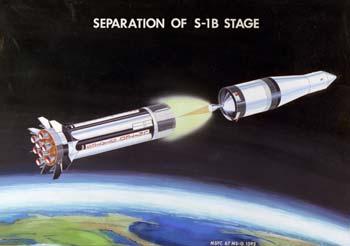Staging of multistage rocket
2009-05-20 16:47 BJT
Often, the required velocity (delta-v) for a mission is unattainable by any single rocket because the propellant, tankage, structure, guidance, valves and engines and so on, take a particular minimum percentage of take-off mass.
 |
| Staging involves dropping off unnecessary parts of the rocket to reduce mass. |
For example the first stage of the Saturn V, carrying the weight of the upper stages, was able to achieve a mass ratio of about 10, and achieved a specific impulse of 263 seconds. This gives a delta-v of around 5.9 km/s whereas around 9.4 km/s delta-v is needed to achieve orbit with all losses allowed for.
This problem is frequently solved by staging — the rocket sheds excess weight (usually empty tankage and associated engines) during launch to reduce its weight and effectively increase its mass ratio. Staging is either serial where the rockets light after the previous stage has fallen away, or parallel, where rockets are burning together and then detach when they burn out.
The maximum speeds that can be achieved with staging is theoretically unlimited. However the payload that can be carried goes down geometrically with each extra stage needed, while the additional delta-v for each stage is roughly constant.

 Mail
Mail Share
Share Print
Print


 Video
Video









 2009 China Central Television. All Rights Reserved
2009 China Central Television. All Rights Reserved